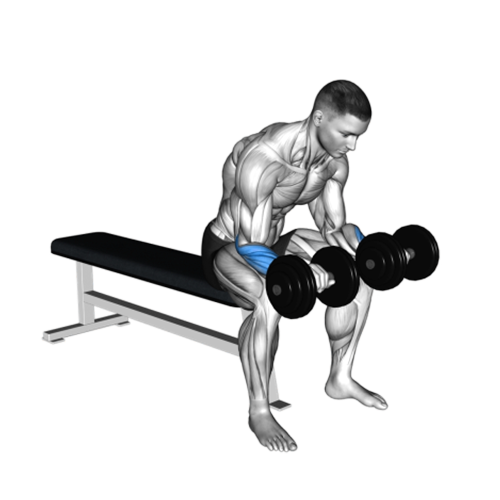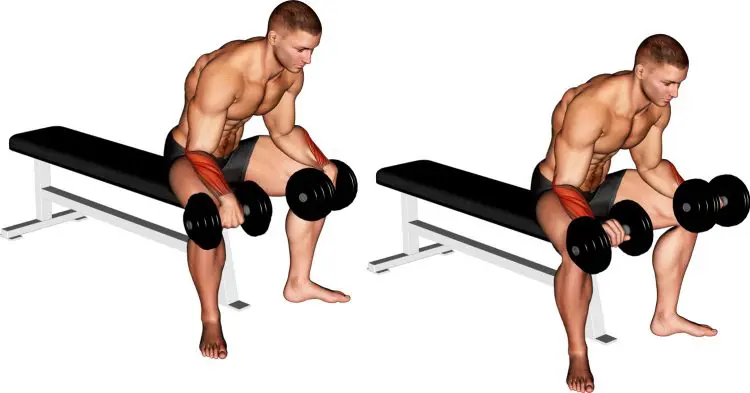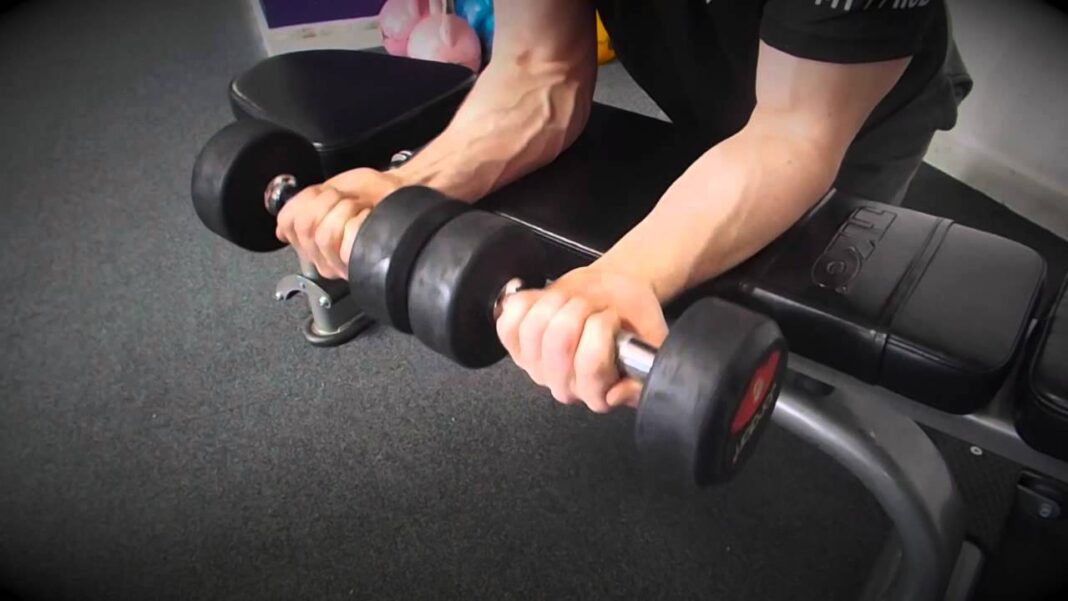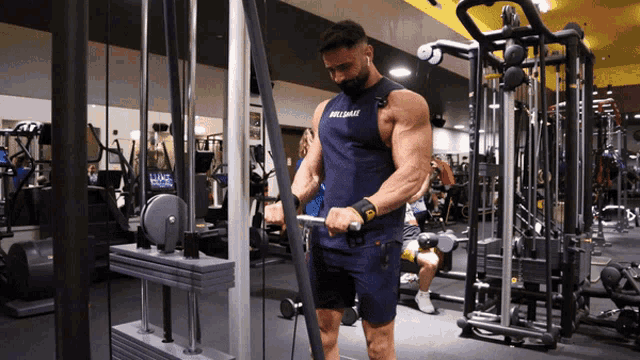Reverse Dumbbell Wrist Curl (Overhand Grip): Building Balanced, Powerful Forearms
Forearm training isn’t just an afterthought — it’s the key to balanced, aesthetic, and functionally strong arms.
For bodybuilders, forearms complete the visual flow from biceps to wrist, giving the arms a thick, dense look even when relaxed. But most lifters overemphasize flexor training (wrist curls, grip work) and neglect the opposing muscle group — the extensors.
That’s where the Reverse Dumbbell Wrist Curl steps in. Performed with an overhand grip, this isolation exercise targets the forearm extensors — the muscles responsible for wrist extension, stability, and control.
These muscles don’t just balance your arm’s appearance; they protect your wrists and elbows, enhance grip endurance, and prevent overuse injuries caused by flexor dominance.
From a bodybuilding standpoint, the Reverse Dumbbell Wrist Curl adds the missing density and separation on the top of your forearm, creating that impressive 3D look when flexing or holding poses. It’s a smaller, more technical lift — but when done consistently, it transforms your arm development and overall performance.
Muscles Worked
Primary Muscles:
- Extensor carpi radialis longus
- Extensor carpi radialis brevis
- Extensor carpi ulnaris
Secondary Muscles:
- Brachioradialis (upper forearm and elbow flexion stabilizer)
- Extensor digitorum (finger extension)
- Pronator teres (forearm rotation control)
💡 Anatomical Note:
The extensors originate from the lateral epicondyle of the humerus (outer elbow) and run down the top of your forearm to your wrist and hand.
They counterbalance the flexors and are crucial for wrist stability during presses, curls, and pulls. Aesthetically, they form the ridge and definition visible on the top side of the forearm.
Why Bodybuilders Should Train the Reverse Wrist Curl
- Balanced Forearm Development
- Prevents the “top-heavy” forearm look and promotes symmetry.
- Improved Grip Stability
- Strengthens the antagonistic muscles that stabilize during heavy lifting.
- Injury Prevention
- Reduces the risk of golfer’s or tennis elbow caused by muscular imbalance.
- Enhanced Aesthetics
- Builds the outer forearm ridge — key for complete, aesthetic arms.
- Increased Functional Strength
- Improves wrist endurance and control in compound lifts, calisthenics, and grappling.
How to Perform the Reverse Dumbbell Wrist Curl
Setup
- Sit on a flat bench with a dumbbell in each hand, palms facing down (overhand grip).
- Rest your forearms on your thighs, allowing your wrists and hands to hang just beyond your knees.
- Keep your elbows fixed and your back straight.
Execution
- Curl Up (Concentric Phase)
- Exhale as you raise the back of your hand toward the ceiling, bending only at the wrist.
- Keep the motion slow and deliberate — avoid jerking.
- Squeeze your forearms at the top for one second.
- Lower Under Control (Eccentric Phase)
- Inhale as you lower the dumbbells slowly, extending your wrists as far as your flexibility allows.
- Pause at the bottom to feel the full stretch before the next rep.
Form Cues
✅ Keep your forearms pinned to your thighs — movement comes only from the wrists.
✅ Use a controlled, full range of motion to engage all the extensor fibers.
✅ Don’t let the dumbbells roll too far forward; maintain grip control.
✅ Focus on tension, not load — lighter weights work best here.
✅ Move both hands evenly; avoid twisting or tilting the wrists.
Common Mistakes and Fixes
| Mistake | Problem | Fix |
| Using too much weight | Encourages momentum, reduces isolation | Drop weight, focus on control |
| Moving the elbows | Engages biceps and shoulders | Keep forearms anchored |
| Partial range of motion | Limits fiber recruitment | Extend wrists fully at bottom |
| Rushing reps | Misses peak contraction | 2-second lift, 3-second lower |
| Ignoring balance | Creates uneven strength | Train both arms equally |
Programming and Volume
For Hypertrophy (Size & Shape)
- Sets: 3–4
- Reps: 15–20
- Rest: 45–60 seconds
- Tempo: 2 seconds up, 3 seconds down
For Strength & Control
- Sets: 4–5
- Reps: 10–12
- Rest: 60–90 seconds
- Focus on moderate weight and stable tempo.
For Endurance / Definition
- Sets: 3
- Reps: 20–25
- Rest: 30–45 seconds
- Prioritize long time under tension.
Bodybuilder Training Tips
💪 Light Weight, High Reps
Reverse wrist curls don’t need heavy loads. Your extensors are smaller muscles — they respond best to controlled, high-rep training.
💪 Consistency is Key
Do them 2–3 times weekly, ideally paired with flexor work (like dumbbell wrist curls) for full forearm coverage.
💪 Feel the Top Squeeze
That one-second contraction at the top is where definition happens — don’t rush it.
💪 Add Volume Gradually
The extensors fatigue quickly. Start with 2 sets per workout and build up to 4 as your endurance improves.
💪 Train Flexors and Extensors Together
Use a superset of wrist curls + reverse wrist curls to maximize pump and balance.
Exercise Variations
- Single-Arm Reverse Dumbbell Wrist Curl
- Focuses on one forearm at a time.
- Enhances symmetry and mind–muscle connection.
- Standing Reverse Dumbbell Wrist Curl
- More challenging for stability.
- Great for athletes or functional strength work.
- Incline Bench Reverse Curl
- Rest forearms on an incline bench for greater stretch and constant tension.
- Behind-the-Back Reverse Wrist Curl
- Unique angle that hits the upper extensor fibers hard.
- Ideal for advanced lifters.
- Cable Reverse Wrist Curl
- Provides smooth, consistent resistance through the full range of motion.
- Excellent for higher-rep hypertrophy training.
Sample Forearm Superset
Perform this combo at the end of your arm or pull workout for maximum pump and balance:
- Dumbbell Wrist Curl (Palms Up): 3×15–20
- Reverse Dumbbell Wrist Curl (Palms Down): 3×15–20
- Farmer’s Carry: 3×30 seconds
💡 Rest: 45–60 seconds between supersets.
This approach floods your forearms with blood and hits both sides equally for complete development.
Advanced Training Techniques
- Time Under Tension (TUT)
- Focus on a 4–5 second eccentric phase for muscle density and control.
- Superset with Reverse Curl
- Alternate reverse dumbbell wrist curls and reverse barbell curls for full upper forearm activation.
- Drop Sets
- Start with moderate dumbbells and reduce weight after failure for continuous tension.
- Isometric Holds
- Hold the top position for 3–5 seconds each rep to maximize contraction.
- Slow Negatives
- Lower over 4 seconds to recruit more fibers and increase time under tension.
Forearm Health and Safety
⚠️ Avoid hyperextending your wrists; keep within a natural range.
⚠️ Warm up with wrist rotations and light sets before working sets.
⚠️ Balance flexor and extensor training to prevent tendon overuse.
⚠️ Stretch forearms after each session to maintain flexibility.
⚠️ If you feel sharp pain around the elbow (lateral epicondyle), rest and reduce load — it may signal extensor strain.
Integration into a Bodybuilding Program
For balanced, aesthetic arm development:
- Train forearms twice per week, alternating emphasis between flexors and extensors.
- Include wrist curls, reverse curls, and grip work together for a complete routine.
- Add forearm work at the end of your arm or back day, when your grip is already taxed.
Example “Forearm Finisher” Routine
- Dumbbell Wrist Curl: 3×15–20
- Reverse Dumbbell Wrist Curl: 3×15–20
- Plate Pinch Hold: 3×30 seconds
- Farmer’s Carry: 3×30 seconds
This combination hits every muscle in the forearm for strength, size, and vascularity.
Bodybuilding Insights
- Arnold Schwarzenegger often trained forearms daily using wrist curls and reverse wrist curls to sculpt the fine detail in his arms.
- Dorian Yates emphasized extensor work for balance and injury prevention during heavy pulling sessions.
- Chris Bumstead includes reverse curls and wrist curls as part of his competition prep to sharpen forearm definition and vascular detail.
For top-tier arm aesthetics, these legends knew: you can’t build perfect arms without balanced forearms.
Strength vs Aesthetic Focus
| Goal | Training Style | Reps | Focus |
| Strength | Moderate weight, strict form | 8–12 | Grip and stability gains |
| Mass | Moderate weight, longer tension | 12–20 | Thickness and fullness |
| Detail | Light weight, high reps | 20–25 | Separation and vascularity |
Practical Takeaways
✅ Use light to moderate weight — form and control are everything.
✅ Train both sides equally to avoid imbalance.
✅ Pair with wrist curls for full forearm activation.
✅ Perform 2–3 sessions weekly for best results.
✅ Don’t neglect your extensors — they’re key to wrist health and balanced development.
Conclusion
The Reverse Dumbbell Wrist Curl might look simple, but it’s one of the most underrated movements for total arm development. It builds the top ridge of the forearm, strengthens the wrist extensors, and ensures your grip and forearm structure stay balanced and resilient.
In bodybuilding, balance equals beauty — and the reverse wrist curl is your tool for achieving that equilibrium between the flexors and extensors.
Add it to your routine, focus on control, and you’ll build forearms that don’t just look powerful — they are powerful.
Strong. Balanced. Complete.
That’s what the Reverse Dumbbell Wrist Curl delivers.





